Japan’s earthquake and tsunami: On prayer, Twitter, and tweeted prayers
A single tweet commencing with “Loving Lord” started me down a path questioning why we tweet, why we pray, and whether prayer has any place in Twitter.
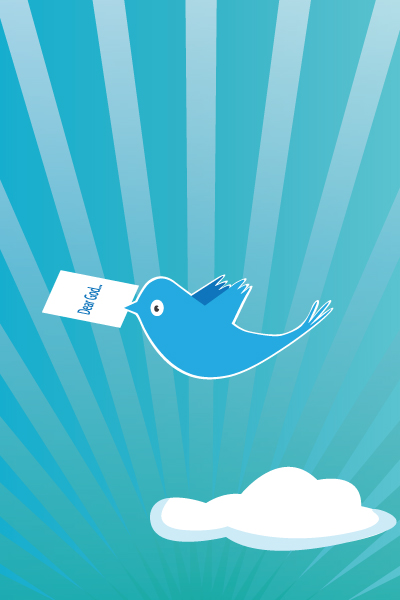
Helpless
On 11 March 2011, the earthquake in Japan garnered around three minutes of my time before I switched to Xbox Tekken during Friday drinks at work. I do not attribute my brevity to callousness, although I can see how that could be the case from a condition I perceive as disaster saturation.
Our local Queensland flood was trumped by the Queensland hurricane which was overshadowed again by the New Zealand earthquake, making disaster a common conversation. I could say my personal experience with losing my house in the floods has given me more of a practical rather than emotional connection with loss. Then again, could I just be desensitised from Hollywood expectations of world-changing catastrophes?
I recall stories of audiences running out of theatres during viewings of the early 1930s King Kong or footage of the Zeppelin crash, clips that could now be shown during Saturday morning cartoons. I watched first-person views of the tsunami levelling entire towns through the same laptop interface that I use to watch countless movie trailers. As such, water rushing over rooftops did not seem complete without some CG-inspired creature contributing to the process.
No, I feel the cause of my passing glance is deeper than mere frequency of disasters, personal experience, or media manipulation of our psyche. I observed in myself and society as a whole an underlying sentiment that governs our focus in such events: helplessness.
The hard reality
Considering the magnitude of the event, helplessness is to be expected. Live blogs, Twitter posts, and newspapers such as The Australian Financial Review unfolded a compelling story in the days following the incident.
- The Quake
The earthquake was a magnitude 9, fourth largest recorded in the world and Japan’s largest, 1000 times more powerful than Japan’s Kobe earthquake. Japan’s seismic risk map indicated there was a 99% risk of a magnitude 7.5 or larger hitting the region in the next 30 years. The quake tilted the earth 10 centimetres off its axis, shoved main island Honshu several metres west, regions nearest the quake dropped up to 70 cm. - The Tsunami
Tsunamis up to 10 metres high travelled up to 100 km/hr, reached up to 10 km inland. The primary cause of death was drowning. - The dead
800 confirmed dead Monday, 1598 Tuesday, 2478 Wednesday, and 7,653 on Saturday. At the time of this post (two weeks after the event), 9,487 are confirmed dead, with 15,617 people missing. - The displaced
As of Saturday, 362,580 people evacuated and staying in shelters, 177,500 evacuated from the 20 kilometre zone around the reactor, 256,819 without power, and 1.04 million homes without water. - Financial impact
Japan is the world’s third largest economy, in economic decline since 1990, gross government debt more than 200% gross domestic product. Quake expected to push Japan into fifth recession in two decades, Bank of Japan pumps AU$181 billion into the banking system, Nikkei share index drops 6.18% Monday, 10.55% Tuesday, third worst fall ever. Interest rates already at 0.1% since 2009, unable to lower. Toyota to miss out on building 40,000 cars, 15% of vehicles sold in the US last year were assembled in Japan. Price for eight gigabyte storage devices rises from $US7.30 to $US10.00. Logistic systems slow, 46 trains stranded, 47 ferry routes suspended. - The power plant
On Monday, the Fukushima Number One power plant reactor building collapsed, seawater used to cool the reactor. Over the next four days, explosions or fires at reactors number 2, 3 and 4. 30 million people live within range of the power plant. Several senior management of the power plant forced to resign in 2002 for falsifying nuclear safety records in 29 cases, operations forced to stop at five plants for safety reasons. Reactors were only rated for a magnitude 7 quake. Rolling blackouts planned, energy supply to be limited until April, supply cut from 41 million kilowatts to 31 million kilowatts, summer expected to push demand up 50%. - The response
100,000 troops, 40% of Japan’s force, committed to the effort. Rescue teams sent from more than 70 countries.
Prayer as a response
As the grim reality of the situation unfolded, hashtags like #pray4Japan became trending topics. Every other tweet seemed to reference “our thoughts and prayers are with you”. Even Lady Gaga offered support through sales of a prayer bracelet.
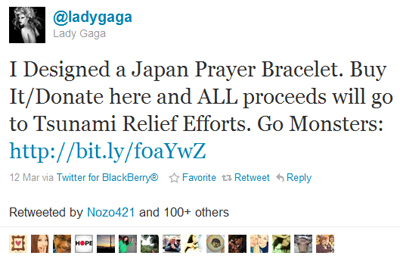
The sudden spiritualisation of Twitter did not make an impact on me until I saw a tweet that started with “Loving Lord”.
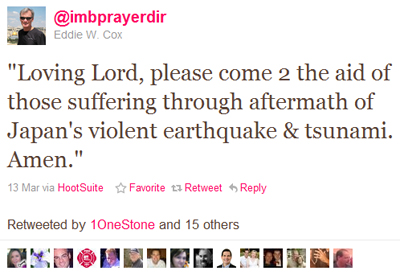
My first obvious question was “Does God read Twitter?” I accept there are a fair few with Twitter accounts claiming to be deity. Given that the tweet was not preceded with the @ sign to indicate a direct reference, I doubt the poster was speaking any of the entities claiming to be deities on twitter.
I know I find it difficult to keep track of the 225 people I follow. I can only imagine the challenges of following 6.9 billion people. Using numbers from the largest reporting religion, Christianity, God’s 2.2 billion followers would make for an undesirable follower-to-following ratio, and I suspect many of the followers don’t read the tweets anyways.
Facetiousness aside, this single directed tweet started me down a path of re-evaluating my thoughts on prayer and whether Twitter was the most appropriate channel for the exercise.
Why tweet, why pray?

I believe the majority of Twitter to be of little value, and there are many who feel the same about prayer. In his book “Prayer: Does it Make any Difference”, Phillip Yancey cites a study that says only 3.4% of us feel satisfied with prayer. He attributes this frustration in part to advances in science and technology removing reliance on what cannot be explained, scepticism, prosperity resulting in a lack of need, time pressures and increasingly succinct communication channels, and the propensity for feedback from other channels like therapy.
Yancey also points to helplessness as a primary motivator towards calling out to something larger than ourselves during situations in which we have no control. This tug-of-war between prayer dissatisfaction and helplessness can result in “middle class whining” and token offerings, with prayer offered up as transactions like ghost money, notes on prayer trees or slips of paper on the Wailing Wall. We question the validity of prayer, but feel helpless to do anything else. Twitter then becomes a low-cost offering to express our helplessness through a public display of care.
I do not purport to be an expert on prayer from either understanding or practice. I take heart in the fact that Yancey, a respected Christian and journalist, wrote the book in his 50s in part to answer his own struggles with the topic. I also respect there are things in this world that cannot be understood.
However, this will not stop me from critically thinking about the topic and understanding as much as we are able. As a student of the social sciences, I turn to a range of research papers and journal articles to discover what we have found about the value of prayer (references available on request):
- 90% of Americans pray at least occasionally, 72% on a regular basis.
- Those who pray for their partner are more willing to forgive their partner and report lower levels of infidelity as compared to those who just had daily positive thoughts.
- Prayer has a positive effect on psychological symptoms of anxiety and anger, improves feelings of gratitude, and may often result in feelings of inner peace, of relief, and of power and support, and the resulting psychological effects can subsequently influence physical health.
- Those characterised by praying for others experience a 48% reduction in health problems as a result of financial strain.
- In a study of 1,278 clergy, a positive attitude towards prayer is associated with lower levels of emotional exhaustion, lower levels of depersonalisation, and higher levels of personal accomplishment.
- Private religious activity, including prayer, provides mortality benefits in older adults.
- Adoration, thanksgiving, and reception type prayers are associated with positive well being, whereas confession, supplication, and obligatory prayers are not.
- Higher prayer frequency by the one consuming alcohol was related to lower problematic drinking behaviour by up to 50%.
These findings demonstrate support for prayer as a benefit to the one praying. The value of distance intercessory prayer is mixed, with some reporting no discernable effect while others show a 50% improvement in those prayed for.
Even as I work through the process of understanding, I acknowledge the paradox of my efforts. Research in itself is a means to gain control by knowing all that can be known. If we could package God in a formulaic box, we would remove our helplessness and thus the primary motivator for prayer.
Defining prayer
Like the narcissistic Twitter platform, prayer can often be all about the one posting the request. Out of our helplessness, we offer up prayers on our terms, only to get frustrated when God does not come to the table. Our dissatisfaction with the practice thereby deepens until the next calamity.
We pray for a parking space and a sunny day in the same breath we would pray for the pain to stop or the earth to calm. One farmer prays for rain, another for clear skies, one gets his prayer answered.
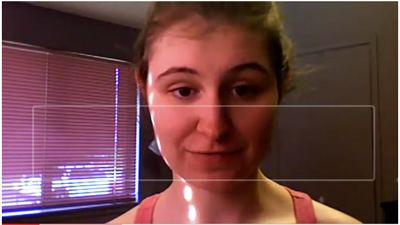
This woman created controversy by saying she prayed for the earthquakes, although she was later proven to be an Internet Troll aiming to create a stir. Anger over the video was based on the notion of a person believing they could direct God in such a way as to cause pain to so many.
In the big scheme of things, the earth will shake and there will be sunny days. Some people will get sick while others miraculously recover. A car accident will take one life yet spare another. I risk minimising much pain and suffering if I infer our prayers can be irrelevant if we apply some perspective, but I know this to be true in my case. I also suspect a balance between the hand of providence and natural laws that is beyond what I can explain.
The onslaught of recent events did help me understand my own feelings of helplessness. I borrow on Yancey as I frame my observations in the following definition of prayer:
An acknowledgement that something is beyond your control, directed at something more important than yourself.
Prayer then becomes an act contrary to a culture that drives us to have control and aspire towards self-importance. The day after the quake, Japanese Prime Minister Naoto Kan stated “I will risk my life on this job”. Less than a week into the event, the Japanese emperor acknowledged the only thing left to do was to pray. The Australian Financial Review took up the sentiment in its headlines: “Japan prays for nuclear fix”.

In times of crisis, world leaders and institutions abdicate authority for that which they have no control. Such sentiments soon get lost as we reaffirm our position of dominance over our lives. Like tweets posted during a crisis, our prayers get lost in the re-establishment of routine.
Early social media preachers depicted Facebook and Twitter as “a conversation”, emphasising “the end of one-way communication”. And yet, the majority of Twitter still feels like mass projectile spew, consisting of 140 character chunks of personal expression. Just as the commercialisation of Twitter can pervert it from its true community form, prayer as a one-way communication appears to reduce the act to a shadow of its true intent.
As I analyse both mediums of Twitter and prayer, I sense from both camps “you don’t get it because are doing it wrong”. Maybe so, but I am grateful for the opportunity to learn from the likes of Mother Theresa, who explained prayer as “I talk… and I listen”. If prayer is a two way conversation and participation benefits the one praying, then it would stand to reason that God would meet you half way as you consistently engage in the process.
Perhaps then I have missed a definition of prayer that highlights a distinction from its use in the Twitter channel:
A relationship
It really is all about me
I find then that prayer becomes about not what will change in the world, but a dialogue with something bigger than me about what will change in me. It is not about changing the situation, but changing who I am in the situation. We pray not then to no longer be helpless, but to gain understanding and find our place in our helplessness.
Ten days after the quake, Japan was replaced on the front page of the Australian Financial Review by a Libyan conflict, arguments over an increase in minimum wage, a threat of a Singapore takeover of the Australian Stock Exchange, and decisions on parliamentary seats for the Treasurer. There never seems to be a shortage of external motivators for prayer.
I wonder what would happen if as a society we were to commit ourselves to praying for events with a focus not to change the situation, but to change ourselves in the situations. Based on research, it would stand to reason that there would then be fewer man-made situations to pray for and a re-focus of effort for natural disasters. Now that would be something to tweet about.
We can only pray.

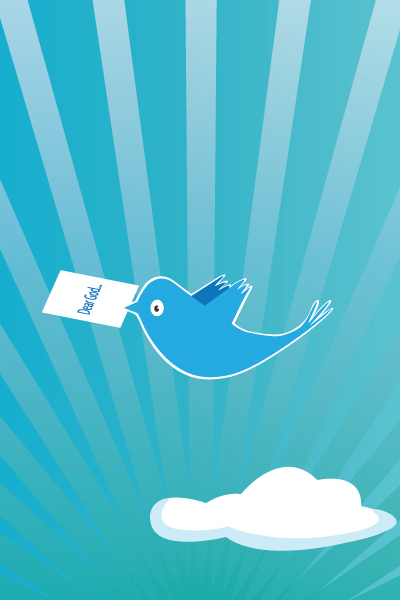
Great post Chad – quite thought provoking. I know a lot of thought went into it.
What I like about people using Twitter to pray – or any other medium for that matter – is that they are engaging with God. God wants us to wrestle with Him, to engage with Him. If we’re Twittering, yelling at Him, or haggling like someone in a market square, at least it’s engaging – which is better than silently simmering and doing nothing with one’s questions and prayers. God doesn’t “need” the prayers and questions to be verbalised per se, He already knows what we are thinking, but it is a part of the relationship that you highlighted: a two way conversation – talking and listening.
“When I pray, coincidences happen, when I don’t, they don’t” — Archbishop William Temple.
God works in and through His Creation in such a way that most answers to prayer are difficult to prove. This is not necessarily a bad thing, for if someone knew that they could pray and “make” things go their way they would become corrupt. “Absolute power corrupts absolutely”, as the saying goes. Rather than seeking out absolute answers to prayer, the Christ-follower is best served living as though all events are answers to prayer in the sense that we believe that all grantings and refusals are what is best from God’s perspective. God works slowly and often to our benefit. Our plans are rarely His plans. His will is the best for me, though not necessarily the easiest.
Ultimately prayer is a mystery. Sometimes God’s felt presence “comes” and “goes” and some prayers will appear to go unanswered, yes, even the best inten¬tioned ones. Nevertheless, I keep at it with the understanding that right now I don’t have a clear view on life and that in the end it’s all going to work out for my good.